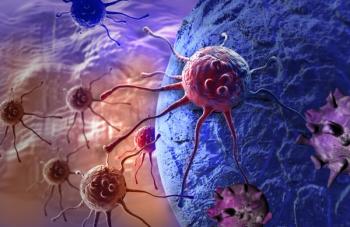
ONS: Nurse-Physician PACT Yields Sharp Decrease in Codes
A team of nurses and physicians from Huntsman Cancer Institute successfully implemented key changes in their Patient Acute Change Team that increased nurse involvement and reduced the number of codes by 90% in the outpatient setting since they were put in place 2 years ago.
A team of nurses and physicians from Huntsman Cancer Institute in Salt Lake City successfully implemented key changes in their PACT, or Patient Acute Change Team, that increased nurse involvement and reduced the number of codes by 90% in the outpatient setting since they were put in place 2 years ago. Joy Lombardi, RN, BSN, OCN, a nurse manager at Huntsman’s Center for Infusion and Advanced Therapeutics, reported on the development and improvement of their PACT in a poster presentation (106981) at the 38th Annual Oncology Nursing Society Congress.
Noting that PACTs, also called Rapid Response Teams, have been implemented across the United States in recent years in an attempt to avert failure-to-rescue events, Ms. Lombardi and her coinvestigators, Bernadette Bittner, APRN, AOCNP, CCRN and Susan Childress, RN, MN, OCN, said studies have shown that having a PACT at your center saves lives; decreases the incidence of codes outside critical care areas; and benefits medical staff, as well as patients. “Like other big institutions, we did institute [a PACT]… partly due to the Joint Commission’s requirement to increase patient safety and rescue patients before they go into a code situation,” Ms. Lombardi said.
The PACT at Huntsman was initiated in 2009 and is available in both the inpatient and outpatient settings, “but we were really having a hard time getting our nurses to use the PACT in the outpatient setting, so we embarked on an educational program to get our nurses more involved” and to let nurses know about the many instances in which a PACT can be used to help outpatients, Ms. Lombardi said. At their academic cancer hospital, she explained, nurses often encounter emergent situations with patients who are receiving outpatient treatment, leading to issues related to difficulty in finding a provider to quickly assess the patient.
Huntsman’s PACT comprises a licensed healthcare provider, nursing supervisor, and transport staff. The Activation Guideline for contacting the PACT includes a change in heart rate of < 40 or > 130 bpm; a change in systolic blood pressure < 90 mm Hg; a change in respiratory rate < 8 or > 30 breaths per minute; a change in mental status or LOC (level of consciousness); suspected stroke; and/or concern about a patient’s condition.
Standing protocols are initiated by nursing personnel or other PACT members with consideration of the following interventions while waiting for a response from the PACT: portable chest x-ray, 12-lead EKG and telemonitoring, IV access and fluid initiation (normal saline 0.9%), oxygen therapy, and ABGs (arterial blood gases). Labs should include CBC (complete blood count); chemistry panel; magnesium, phosphorous, and calcium levels, and glucose stick; troponin I, CK (creatine kinase), and BNP (B-type natriuretic peptide); albumin, PT (prothrombin time), PTT (partial thromboplastin time), and INR (international normalized ratio; to standardize PT results).
In 2011, the CPR Committee at Huntsman decided that an important improvement would be to add an automatic electronic pager message to the facility’s respiratory and laboratory resources when the PACT is called. Also in 2011, based on a review of outcomes and utilization, an education program was launched in the outpatient setting to encourage increased use of the PACT by nursing staff: The PACT was promoted by nursing leadership through informational orientation meetings, posters, pocket cards, and education at staff meetings, using the slogan, “Need a Doc? Call a PACT!” In educating staff and promoting the PACT, the staff educator “gave permission to call even with symptoms as vague as ‘the patient doesn’t look good,’” Ms. Lombardi said. (See the accompanying video.)
Ms. Lombardi and her coinvestigators emphasized that “all hospital staff, including medical assistants, registration staff, valets, and cooks, [can] use the PACT to get immediate medical attention for patients, visitors, and staff,” so “staff is empowered to act rather than wait for test results, callbacks, or change in condition” of the patient.
The 2011 educational program and addition of the automatic page to the phlebotomy and respiratory therapy departments have had a positive and far-reaching impact: The PACT is more widely used at Huntsman, and clearly, staff members are relying on it. In the outpatient setting, the effect of the PACT in the past 2 years has been a 90% decrease in codes and a significant increase in PACT calls.
A survey of 19 clinical RNs showed nearly all “agreed” or “strongly agreed” that the PACT has been helpful in managing a patient in crisis, has helped to keep patients from going to the emergency department, has improved patient safety, and has had adequate response times. The nurses also said they would call a PACT in the future. In particular, Ms. Lombardi and her coauthors noted that with the PACT now solidly in place, nursing staff “feel well supported when assessing patients who emergently present with acute changes that have high potential for cardiopulmonary compromise.” They also said they believe physician participation in their PACT is essential to its success, and would recommend this model for use in other oncology centers.
The investigators are continuing to evaluate the data on their PACT program and plan to refine the program as needed based on their findings. Future considerations for study, Ms. Lombardi said, include assessment of their PACT’s impact on mortality, investigation of its use in high-risk populations, and evaluation of its application to developing possible preemptive solutions in the management of at-risk patients.
Newsletter
Stay up to date on recent advances in the multidisciplinary approach to cancer.





